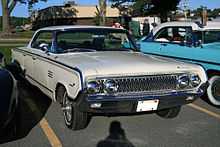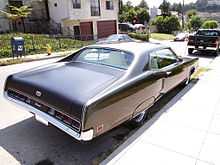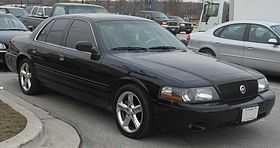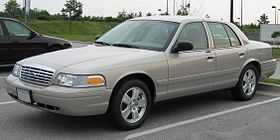Mercury Marauder
| Mercury Marauder | |
|---|---|
 A Mercury Marauder in 2007 | |
| Overview | |
| Manufacturer | Ford Motor Company |
| Production |
1963–1965 1969–1970 2003–2004 |
| Body and chassis | |
| Class | Full-size |
| Layout | FR layout |
The Mercury Marauder was the name of three different automobiles made by the Mercury division of Ford Motor Company. During the 1960s, the Marauder was introduced as the high-performance model of the full-size Mercury line; its Ford equivalent was the Galaxie. From 2003, the Marauder nameplate was revived as a high-performance variant of the full-size Grand Marquis. After lower than expected sales, the Marauder was discontinued at the end of the 2004 model year.
First generation (1963–1965)
| First generation | |
|---|---|
 1964 Mercury Marauder 2-door hardtop | |
| Overview | |
| Production | 1963½–1965 |
| Body and chassis | |
| Body style |
2-door hardtop 4-door sedan |
| Platform | Full-size Ford |
| Related |
Mercury Monterey Mercury Montclair Mercury Park Lane |
| Powertrain | |
| Engine |
390 cu in (6.4 L) V8 406 cu in (6.7 L) V8 427 cu in (7.0 L) V8 |
| Transmission |
3-speed manual 4-speed manual 3-speed automatic |

The Marauder name first appeared in 1958. The 383 Marauder engine was an Option from 1958- 1960. The MEL 383 Marauder was rated at 330 hp @4800 RPM, 425 ft lb @3000 RPM. It was available in the Montclair and Colony Park models in 1958 and the Montclair only in 1959. In 1960 it was a special option for any Mercury. The 1963½ model in the full-size Mercury lineup was available as a 2-door hardtop with a forward-slanted "fastback" roofline; this was the reverse of the Breezeway roof introduced on other full-size Mercurys. This fastback roofline was developed for both the Mercury Marauder and the Ford Galaxie for NASCAR competition, and may have helped with the many 1963–64 Ford Mercury victories. In 1964, the Marauder became available in a four-door sedan, also with a fastback roofline. It was an option on the Monterey, Montclair, and Park Lane. Marauders also featured bucket seats, central consoles, and other trim items similar to those in the Ford Galaxie 500/XL.
As it was common practice during that time to share components between Ford and Mercury, powertrain choices for the Marauder were identical to the big Ford, including 390, 406, and 427 cubic-inch Thunderbird V8s, (which Mercury labeled Marauder and Super Marauder V-8s) and a choice of 3-speed or 4-speed manual, or 3-speed automatic transmissions.
After 1965, the Marauder name was discontinued. The nameplate lived on as the branding of the most powerful engine available in Mercurys in 1966 and 1967 and could be found in other full-size Mercurys including the Mercury S-55.
Second generation (1969–1970)
| Second generation | |
|---|---|
 1969 Mercury Marauder X-100 | |
| Overview | |
| Production | 1969–1970 |
| Body and chassis | |
| Body style | 2-door hardtop |
| Related | Mercury Marquis |
| Powertrain | |
| Engine |
390 cu in (6.4 L) FE V8 429 cu in (7.0 L) 385 V8 |
| Transmission |
3-speed FMX/SelectShift automatic 3-speed C6/SelectShift automatic 3-speed manual |
| Dimensions | |
| Wheelbase | 121.0 in (3,073 mm)[1] |
| Length | 219.1 in (5,565 mm)[1] |
| Width | 79.6 in (2,022 mm)[1] |
| Height | 53.5 in (1,359 mm)[1] |
| Curb weight | 4,328 lb (1,963 kg)[1] |

In 1969, the Marauder was reintroduced into the Mercury lineup, largely as a replacement for the S-55. As a part of a shift from a performance model to a full-size personal luxury coupe, it was based upon the recently introduced Marquis, sharing its front clip and much of its interior.
From the windshield rearward, the Marauder wore a separate body from the Marquis. In a design similar to the Ford XL and Ford Galaxie 500 SportsRoof, it wore a "fastback" roofline with a tunneled rear window. To distinguish it from its Ford counterparts, the Marauder wore non-functional louvered side air intakes in the quarter panels. A performance trim level of the Marauder was sold as the Marauder X-100. Largely for appearance purposes, the X-100 wore bucket seats with a floor console housing a U-shaped automatic transmission shift handle. On the outside, X-100s were fitted with sporty Kelsey-Hayes stylized road wheels complete with rear fender skirts.
The market for sporty full-size cars had disappeared, though, and production was limited to about 15,000 cars for 1969 and barely a third of that for 1970. While the market for personal luxury cars was expanding, the Marauder found itself competing against the Ford Thunderbird and Lincoln Continental Mark III; it was outsold by the Lincoln by nearly four to one.
Mechanical details
Standard versions of the Marauder were equipped with a 390 cubic inch engine; the Marauder X-100 was normally equipped with a larger 360 hp (268 kW) 429 cubic inch engine. With the 390, a 3-speed manual transmission was technically standard, with a 3-speed FMX automatic as an option. The sole transmissions for the 429 was the C6 automatic.
Revival (2003–2004)
| Third generation | |
|---|---|
 2003–2004 Mercury Marauder | |
| Overview | |
| Production |
2003–2004 11,052 produced |
| Assembly | St. Thomas Assembly Plant, St. Thomas, Canada |
| Body and chassis | |
| Platform | Ford Panther platform |
| Related |
Mercury Grand Marquis Ford Crown Victoria Lincoln Town Car |
| Powertrain | |
| Engine | 4.6 L Modular DOHC V8 |
| Transmission |
4-speed 4R70W automatic (2003) 4-speed 4R75W automatic (2004) |
| Dimensions | |
| Wheelbase | 114.7 in (2,913 mm). |
| Length | 212.0 in (5,385 mm). |
| Width | 78.2 in (1,986 mm). |
| Height | 56.8 in (1,443 mm). |
At the 2002 Chicago Auto Show, Ford introduced the Mercury Marauder as a concept car. The first full-size convertible produced by Ford since the 1971 Mercury Marquis and Ford LTD, the Mercury Marauder was also the first two-door full-size car since 1987. Largely intended as a preview of the Marauder sedan going into production for the 2003 model year, the convertible was powered by the 4.6L Modular V8; an Eaton supercharger increased output to 335hp.[2] Based on a 1999 Ford Crown Victoria LX, the Marauder concept car had its body changed to a two-door layout with five-passenger seating with a floor shifter for the automatic transmission.[3]
In 2000, Ford chose to approve the production of the Marauder as a sedan for the 2003 model year.[4] After a 33 year absence, Ford resurrected the Mercury Marauder name as a high-performance companion model for the Mercury Grand Marquis. Although the Mercury division was most directly a competitor to Buick (and before that, Oldsmobile), the design of this Marauder drew many parallels to the 1994–1996 Chevrolet Impala SS in being a contemporary full-size "muscle sedan",[5] and both being derived from a police vehicle (the Marauder from the Ford Crown Victoria Police Interceptor, and the Impala SS from the Chevrolet Caprice).
To differentiate itself from the Grand Marquis and the Crown Victoria, the Marauder borrowed and customized trim parts from both its Ford and Mercury stablemates while creating its own, monochromomatic design image. The headlights and corner lights, from the Grand Marquis, had its non-reflective surfaces blacked out and the grille was painted black with a body-color surround. Side trim was shared with the Crown Victoria (B-pillars painted body color), along with the trunklid and taillights (tinted to just within DOT standards). Unique body parts include a front bumper with its own air intake and Cibié fog lamps and a rear bumper embossed with Marauder (in a fashion similar to the Ford Mustang). While the grille and trunk wear standard Mercury "waterfall" emblems, the car's five-spoke 18" wheels feature Mercury's classic "god-head" (Mercury's silhouette) emblem on its center caps. Aside from the lights, only the Mercury emblems, wheel rims, and window trim are reflective.
In contrast to the Grand Marquis, the interior of the Marauder featured front bucket seats and a floor shifter with a center console; leather seats were standard. Instead of the simulated wood trim seen in the Grand Marquis, the Marauder substituted simulated satin aluminum trim in its place. The instrument cluster was Marauder-specific, with satin aluminum gauges (with a 140-mph speedometer borrowed from the Ford Police Interceptor) and the pressed electrical board to control them are model-exclusive. To make room for the tachometer, the oil-pressure gauges and voltmeter were moved to the center console. The Marauder is also the only Panther car after 1997 with a specific pin on the PCM for a tachometer.
Mechanical details
The Mercury Marauder was based on an updated version of the Ford Panther platform that was introduced for 2003. The Marauder had a naturally aspirated 4.6 L V8 DOHC Ford Modular engine producing 302 hp (225 kW) and 318 ft·lbf (431 N·m) of torque; this engine had many parts — including heads, cams, block and rotating assembly — in common with the 2003–2004 Mustang Mach 1 and the 2003–2005 Lincoln Aviator. The Marauder featured a dual exhaust system with MEGS tailpipe tips, with newly developed chassis and suspension modifications – such as moving the rear shocks outboard of the frame rails, which were later made available for the Crown Victoria and Grand Marquis. The Marauder was fitted with the 4R70W 4-speed automatic in 2003 and received the upgraded 4R75W 4-speed automatic for 2004. Both years featured the aluminum drive shaft from the Ford Crown Victoria Police Interceptor. The limited slip differential with a 3.55 rear axle ratio was standard fitment on all Marauders.
Reaction

The 2003–2004 Marauder sales fell short of corporate forecasts, and after a production run of 11,052 vehicles, the Marauder was discontinued at the end of 2004.[6] For comparison, Mercury produced 179,723 examples of its Grand Marquis counterpart during the same time. The number of Marauders produced per year in each color breaks down as follows:
2003 – Total: 7838 (328 Dark Pearl Blue, 417 Silver Birch, 7093 Black)
2004 – Total: 3214 (980 Dark Toreador Red, 997 Silver Birch, 1237 Black)
References
- ↑ 1.0 1.1 1.2 1.3 1.4 "Mercury Marauder X-100 (1970) full detailed specifications listing and photo gallery". Retrieved 25 January 2014.
- ↑ http://www.caranddriver.com/news/mercury-marauder-convertible-concept-auto-shows
- ↑ http://jalopnik.com/5837099/topless-mercury-marauder-concept-car-on-ebay/
- ↑ http://media.ford.com/article_display.cfm?article_id=10953
- ↑ "Mercury follows Impala formula for Marauder". Automotive News. 5 November 2001.
- ↑ Ford Performance Group. "Ford Performance Group". Ford Performance Group. Retrieved 2011-03-18.
Further reading
- Edmunds.com, 2003 Marauder Review
- AutomobileMag.com, 2003–2004 Mercury Marauder, Joe Lorio
- Car and Driver, July 2002, 2003 Mercury Marauder - Reviews / Road Tests, John Phillips
- Car and Driver, 2004 Mercury Marauder, User Road Tests
- Motor Trend, July 2002, Merc Meets Merc, Marauder and S500: Two cool, bad-ass powerbrokers on the run, Todd Lassa
- JD Power Quality Survey, 2003 Mercury Marauder
External links
| Wikimedia Commons has media related to Mercury Marauder. |
- http://www.MercuryMarauder.net
- http://www.MotorCityMarauders.com
- http://www.MercuryMarauder.org
- http://www.fordperformancegroup.com
| ||||||||||||||||||
| « previous — Mercury passenger vehicle timeline, 1980–2011 | |||||||||||||||||||||||||||||||||
|---|---|---|---|---|---|---|---|---|---|---|---|---|---|---|---|---|---|---|---|---|---|---|---|---|---|---|---|---|---|---|---|---|---|
| Type | 1980s | 1990s | 2000s | 2010s | |||||||||||||||||||||||||||||
| 0 | 1 | 2 | 3 | 4 | 5 | 6 | 7 | 8 | 9 | 0 | 1 | 2 | 3 | 4 | 5 | 6 | 7 | 8 | 9 | 0 | 1 | 2 | 3 | 4 | 5 | 6 | 7 | 8 | 9 | 0 | 1 | ||
| Coupe | |||||||||||||||||||||||||||||||||
| Sport compact | Capri | Capri | Cougar | ||||||||||||||||||||||||||||||
| LN7 | |||||||||||||||||||||||||||||||||
| Personal luxury | Cougar | Cougar | Cougar | ||||||||||||||||||||||||||||||
| Sedan | Subcompact | Bobcat | Lynx | Tracer | |||||||||||||||||||||||||||||
| Compact | Tracer | Tracer | |||||||||||||||||||||||||||||||
| Zephyr | Topaz | Topaz | Mystique | ||||||||||||||||||||||||||||||
| Mid-size | Cougar | Marquis | Sable | Sable | Sable | Sable | Milan | ||||||||||||||||||||||||||
| Monarch | |||||||||||||||||||||||||||||||||
| Full-size | Marquis | Montego | Sable | ||||||||||||||||||||||||||||||
| Grand Marquis | Grand Marquis | Grand Marquis | Grand Marquis | ||||||||||||||||||||||||||||||
| Marauder | |||||||||||||||||||||||||||||||||
| Station Wagon | Subcompact | Bobcat | Lynx | Tracer | |||||||||||||||||||||||||||||
| Compact | Tracer | Tracer | |||||||||||||||||||||||||||||||
| Zephyr | |||||||||||||||||||||||||||||||||
| Mid-size | Cougar | Marquis | Sable | Sable | Sable | Sable | |||||||||||||||||||||||||||
| Full-size | Colony Park | ||||||||||||||||||||||||||||||||
| Light truck | |||||||||||||||||||||||||||||||||
| SUV | Mariner | Mariner | |||||||||||||||||||||||||||||||
| Mountaineer | Mountaineer | Mountaineer | |||||||||||||||||||||||||||||||
| Minivan | Villager | Villager | Monterey | ||||||||||||||||||||||||||||||